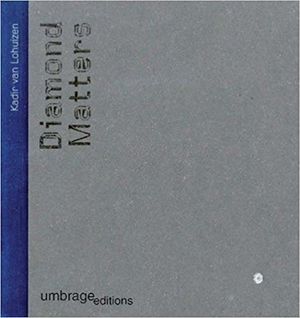Cem/kadirlohuizen
Diamond Matters by Kadir van Lohuizen
Diamond Matters
Hardback, part suede bound Dewi Lewis Publishing. 12cm x 11cm
Kadir van Lohuizen is a Dutch photographer who started out his career as a photojournalist. He's been known for his work on social issues, and has been deeply involved with the conflicts in Africa. He has won the De Zilveren Camera (The Silver Camera, a prestigious Dutch press photo award) four times, and also the Visa D'or and many others.
His book, Diamond Matters is a take on a diamond trade, and tells us the journey of a blood diamond from the beginning to the end. It starts with the miners in Africa, and ends with the jet set society in Europe.
The book is about the journey of a diamond through the industry, while it passes through the lives of the people who are in contact with it in any way. Starting with the mines in Africa, in countries that formerly suffered from the blood diamond trade and the war amongst the rebel forces that were feeding from this trade; we see both children and old people amongst the way, living in the mines, working for food, getting paid only if they find a carat. As we go deeper into the story we see all the aspects of the industry, like the mine owners, licensees, diamond offices, traders, cutters, cleaners etc.
The main deal of the book is the correlation between the story of the diamond, and the paper quality. As we turn the pages, the paper quality changes from rough to glossy. It contains five different types of papers. We can see the biggest difference when a diamond is found, and the pages become shinier, as we continue with the journey of the diamond towards the west, through the world of luxury.
There is not a one particular way that all the photographs are placed on the pages of the book, some are aligned to left, some to right, sometimes images covering both pages and occasionally we bump into pages that are folded and which can be viewed as panoramic photographs depicting the environment to us. The only definitive choice is with the square photo format is used when it is accompanied by an excerpt from an interview.
We see only twice in the book this choice of putting a quote in the center of a page, taken from an interview, without any photos, that says:
"We work here in Chingulu mine, but we come from Dondo. We work seven days a week, but live here in the camp. They only give us food, but if anything is found, we get part of the proceeds. A week ago we found a carat."
---
"Clients usually come by appointment. They rarely buy at once. They go away and think about it and then they come back."
This choice can be thought as a way of signfying opposing ends.
It is essential to remember that Van Lohuizen is a photojournalist, and his approach to this story is not only with photography but also with the interviews. This is a story about the diamond industry, which goes through the people who are in it.
I did not like the choice of the font that is used throughout the book. I understand that it was chosen in order to give the feeling of the texture of a diamond, but my thought is that it looks too digitized. A typewriter font, or a sans serif font could have suited it better.

